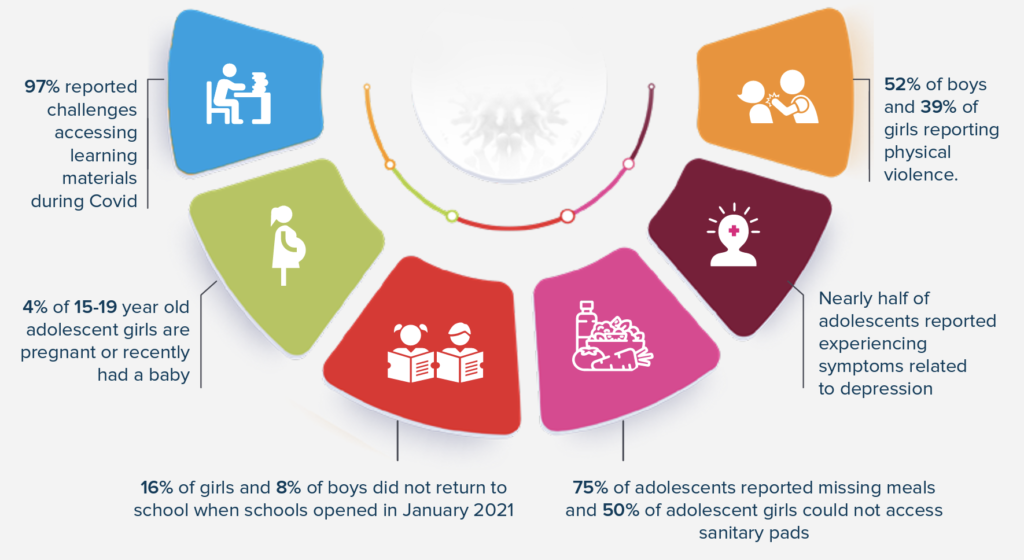July has been another difficult month in the arc of the COVID-19 pandemic and its effect on school systems. The Delta variant continues to surge and has led to continued and renewed school closures in many countries. Simultaneously, evidence continues to pour in underscoring just how devastating these school closures have been for the world’s children. Here are a few data points we’ve seen come out this month:
- Recent evidence from Senegal suggests that re-enrollment is stronger than expected amongst both girls and boys, but that masks high repetition rates and inequality fueled in part by wealthier families leaning heavily on private tutoring.
- “Millions of children in Latin America may have already left the school system.”
- Even where dropouts seem relatively low overall, adolescents have been less likely to re-enroll. Among adolescents aged 10-19 in Kenya, 16% of girls and 8% of boys did not return when schools opened in January 2021. They also reported high rates of physical violence and symptoms related to depression, among other troubling outcomes (see figure below).
- Underscoring the especially precarious position of adolescent girls, Amplify found stark physical, economic, health, social, and personal barriers to girls returning to school in East Africa. The primary pathway to girls dropping out were economic barriers, which led girls to engage in transactional sex, causing unintended pregnancies that forced girls out of school.
- This report also documents gender-based violence for adolescent girls in Kenya as a result of the pandemic.
- More broadly, it is as yet unclear whether the budget private school sector in countries like India will survive the pandemic

The longer closures persist, the more devastating they become and the more we understand their impacts on children. This has created a growing chorus of voices urging governments to re-open schools, as in a recent article in The Economist. Elsewhere, Rukmini Banerjee and Poonam Muttreja underscore how shutting schools across the board in the first place may not have been the best response, and waiting for a “golden moment when suddenly [the pandemic] will be over and the schools will open” is unrealistic. We need to find a way to re-open and effectively support students now, especially the most vulnerable.
Beyond re-opening schools, what are some promising and needed approaches to support children’s learning?
- Focus on building connections and competencies, not cramming content. The “most successful [interventions] were not the exercises to impart learning, but which were able to establish two-way communication.”In returning to school, it is unrealistic to think we can recover all the content that was missed. Curriculum was always prone to leave students behind — this is a chance to set the curriculum aside and focus instead on imparting key competencies, especially foundational learning.
- A recent World Bank report highlights the prevalence, impact, and potential to stem violence in and beyond schools.
- Amplify offers six recommendations to support adolescent girls: (1) Provide material resources and alleviate economic vulnerability; (2) Offer pathways for pregnant girls and young mothers to continue and complete their education; (3) Combat the stigmatization of pregnancy and teen-motherhood; (4) Provide psychosocial support, counseling and mentoring; (5) Establish effective community-based sexual reproductive health and rights (SRHR) initiatives; and (6) Make remote learning accessible (e.g. through printed materials that require no technology or low tech options like SMS)
We can expect some of the similar challenges around mental health, violence, food insecurity and more as a result of future disasters and disasters-in-the-making like climate change, so now is a good time to learn our lessons.
In other news:
- A recent systematic review published in the Lancet finds “that lower maternal and paternal education are both risk factors for child mortality” and therefore universal quality education can help to reduce neonatal and child mortality.
- A new report by the REAL Centre documents a “chronic lack of funding in pre-primary education”
- The Dignity Report argues why dignity matters in development, and provides practical tools and examples for embedding dignity in the way we do work.
- Niharika Gupta and Sameer Sampat explore how teacher expectations empower student learning
Depending on how you look at it, July’s Global Education Summit was either a big success in raising a record US$4 billion for the Global Partnership for Education, or it was a failure for falling short of its $5 billion goal, in no small part due to disappointingly low commitments from the United States and the Summit’s host, the UK. Either way, it was good to see the Summit underscore girls’ education through a session on Gender Equality in and through Education. And we certainly need to shore up all the support we can to tackle the pressing challenges highlighted in this post.
